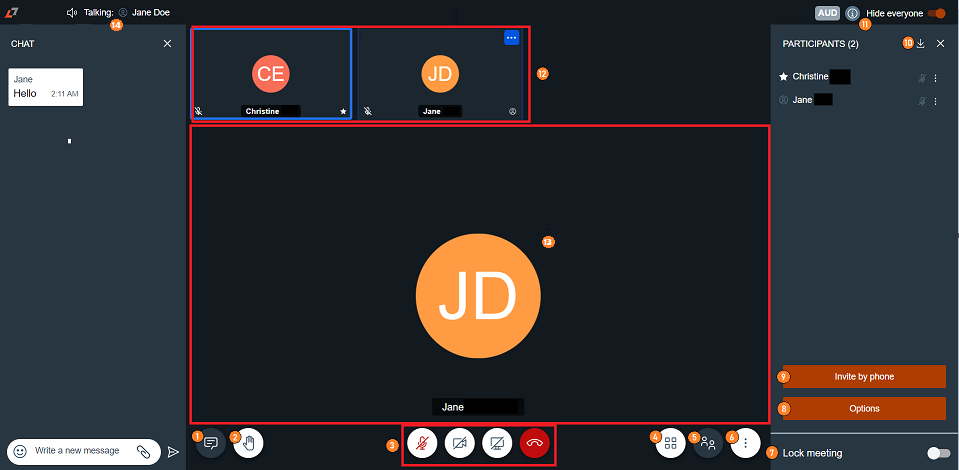Inside a Sametime meeting
This section provides information on the features visible to the user after joining a meeting. For more information on how to join a meeting, refer to Joining a Sametime meeting.
Procedure
After joining a meeting, users see the following points in the meeting room. Some features can be configured based on user preference. Depending on the user’s role (owner, moderator, participant, or guest), some options may be unavailable.

Some features are configurable by the user and others are limited based on server configuration. Company policies determine feature availability. Contact the Sametime administrator for questions about feature availability.
- Chat
- Expands and collapses the chat window that allows users to interact with other participants in the meeting.
- Raise hand
- Allows users to notify meeting participants of a response to a binary poll.
- Allows users to silently request attention from moderators or participants.
- A user can lower their hand. The moderator can also lower hands individually or collectively.
- Standard meeting controls
- Microphone
- Control the microphone in the meeting.
- Browser permissions must be granted to enable the microphone.
- This control is separate from the microphone control on the operating system.
- The moderator can disable participant microphones individually or collectively.
- Camera
- Users can enable video in the meeting.
- Browser permissions must be granted to enable the camera.
- The moderator can turn off active cameras.
- The video stream of users is limited to the last few speakers. All other videos are hidden until the user speaks.
- Screenshare
- When screen sharing is enabled, you have the option to share part or all of your screen.
- Browser permissions must be granted to allow screen sharing (called screen recording on macOS).
- If greyed out, screenshare is disabled by the moderator.
- Leave
- Any user, including a moderator, can exit a meeting while the meeting is in progress without automatically ending the meeting.
- If another moderator is on the participant’s list, the meeting continues as normal.
- If all moderators exit a meeting, the meeting ends after __ if a moderator does not return.
- Microphone
- Toggle tile view
- Changes the layout of individual participant windows including video streams and screen sharing windows.
- Participant list and more
- Allows the user to view a vertical list of all participants.
- Users can view moderator, guest, and presenter according to icons.
- Moderators use this list to grant and revoke permissions, disable microphones/cameras and kick out participants.
- More actions
- Manage video quality
- Default is HD (High definition).
- Depending on network connections, the user may choose to increase or decrease the quality.
- Change background
- When the camera is enabled, you can add a filter to blur your surroundings or use an image to obscure your background.
- View full screen
- Maximize the meeting browser window.
- Click escape to return to a standard window.
- Share a video
- By default, regardless of access level, anyone can share a video during a meeting. The video is viewable by all participants.
- Start live stream
- Moderators can convert an interactive meeting to a lecture-style, view-only meeting.
- The meeting automatically streams on YouTube.
- A link is provided to share with all participants.
- Contact your administrator for YouTube streaming requirements.
- Copy the meeting link
- Allows the user to copy a full url for the meeting to share with invitees.
- End-to-end encryption
- For secure communications that prevent third parties from accessing data, you can enable E2EE. Recordings and live streaming are not available in an encrypted meeting. Users joining from mobile and unsupported browsers cannot participate in E2EE meetings.
- Start recording
- Available to all moderators to record a meeting.
- When recording has started, the moderator sees the option to Stop recording.
- End the meeting
- This option is available to moderators.
- Any moderator can use this option to end the meeting.
- This immediately ends the meeting for all participants.
- This option also automatically stops all recordings when the meeting is ended.
- Settings
- Users can adjust their device settings.
- Moderators can also do the following:
- Add a meeting password.
- Change from a moderated meeting to an instant meeting.
- Allow guest users (this option is enabled by default).
- Manage video quality
- Lock meeting
- Prevents additional participants from joining the meeting.
- Useful to prevent users from a subsequent meeting from entering early.
- Control participants when sharing confidential information.
- Can be toggled at any time throughout the meeting.
- Options
- Only visible to meeting moderators and owners.
- Lower all hands.
- Mute everyone else without notification.
- Turn off all cameras without notification.
- Invite by phone
- Available if the feature is enabled by the Sametime administrator.
- Allows the moderator to add other participants to a meeting through a telephone number.
- Download meeting report
- You can generate a report during the meeting by selecting the download button from the participants list. For more information refer to Participant View Controls.
- Hide everyone
- Only visible when participants are at the top row view.
- Hide the individual participant windows on the top row.
- Keeps the focus only on who is speaking or on active screen share.
- Horizontal participants view
- Displays each participant window with initials, a picture, active camera, or screen share depending on users’ status.
- Interactive view
- Displays a focused view of one selected user’s window.
- This may be a shared screen, active camera, initials, or a saved image.
- This view is impacted by the Toggle tile view option.
- Talking
- Displays the name of the active speaker.